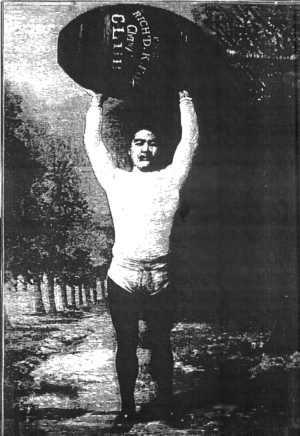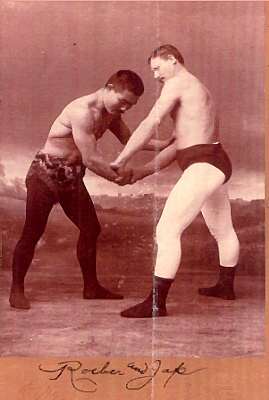سوراکیچی متسودا نیویارک میں انتقال کر گئے۔
سوراکیچی متسودا نے دیر سے امریکہ کا سفر کیا۔ 1883 اپنے پیشہ ورانہ ریسلنگ کیریئر کا آغاز کرنے کے لیے. متسودا نے امریکی پیشہ ورانہ ریسلنگ سیکھنے اور اپنے وطن واپس آکر ریسلنگ کو فروغ دینے کا ارادہ کیا۔.
متسودا کے مینیجر نے جاپان میں اپنی تربیت کے بارے میں دعویٰ کیا۔, which could not be verified. Matsuda trained in sumo wrestling with the famous Isegahama stable but did not achieve any significant sumo rank. Professor Kirby said Matsuda won fifty-three of one hundred matches.

Matsuda Sorakichi from the Public Domain
Matsuda started his career by wrestling Edwin Bibby, who beat Matsuda quickly in two straight falls. Matsuda continued to improve and finally defeated Jack Gallagher for his first notable win although Matsuda had defeated other wrestlers.
Evan “Strangler” Lewis earned the ire of the fans by refusing to release a guillotine choke after Matsuda submitted to Lewis in early 1886. Fans thought Lewis was going to kill Matsuda.
In the rematch a few weeks later, Lewis sprained or tore the ligaments in Matsuda’s ankle causing a significant setback in Matsuda’s career. Matsuda continued wrestling but never broke through against the elite like Lewis, ولیم Muldoon, and Martin “Farmer” Burns.
Matsuda married an American heiress, Ella B. Lodge of Philadelphia, in New York City in February 1885. The marriage was not a happy one due to Matsuda’s alleged abusive conduct.
In March 1885, مسز. Matsuda tricked Matsuda into showing up at a New York Police Station, where she swore out a complaint against Matsuda. Matsuda denied the accusations, but his marriage was over after only a few months.
Matsuda lived in New York City, where he frequently walked down Mott Street, a tough section of the city. Hoodlums attacked the five-foot, five inches but one hundred seventy pound wrestler. Matsuda dispatched the toughs easily leaving one or two unconscious on the street. The bullies learned to give Matsuda a wide berth when he took his evening stroll.

Sorakichi Matsuda and Ernst Roeber demonstrating wrestling in the late 1880s
Matsuda travelled to Nebraska to wrestle Martin “Farmer” Burns in 1890. It proved to be Matsuda’s last professional match. Sometime between this match and the summer of 1891, Matsuda contacted tuberculosis, or “consumption”, a death sentence in the 19th سینچری.
Three months prior to his death, Matsuda convalesced between his boarding house and St. Vincent’s Hospital. Matsuda was destitute for the last several months of his life but the Japanese community in New York City took care of all his bills allowing him to live comfortably for his last few months.
ہفتہ, اگست 16, 1891, the once powerful Sorakichi Matsuda barely made it to the Nippon Club across the street from his boarding house. Exhausted by the effort, Matsuda fainted in the club around 4 بجے. Unable to revive him, his friends sent for a doctor but it was too late. Sorakichi Matsuda died in his favorite club at 32 پرانے سال.
His friends provided a lavish funeral that nearly all of New York City’s Japanese community attended. His friends also paid for his burial in New York City’s Woodlawn Cemetery.
Matsuda never completed his dream of bring professional wrestling to Japan. It would take sixty more years before another former sumo wrestler brought professional wrestling to Japan in a big way.
You can leave a comment or ask a question about this or any post on my Facebook page.
Sources: Star-Gazette (Elmira, New York), اگست 18, 1891, P. 8
یہ پن

